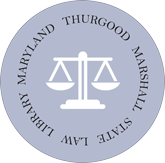Audubon's Birds of America are on permanent exhibit at the Thurgood Marshall State Law Library. The Library's Special Collections Room is open to the public by appointment. To schedule an appointment, call us at 410-260-1430 or email [email protected].
The Conservation Challenge | Audubon and His Prints | Informational Brochure | View the Prints
The Conservation Challenge
In 1833, the State Library’s first librarian, David Ridgely, entered into an original subscription on behalf of the State of Maryland for The Birds of America and the accompanying five-volume Ornithological Biography. The total cost for the collection was approximately $1,000. The Audubon collection along with related original correspondence, sales receipts, and other ephemera is one of the highlights of our Special Collections Room.
The Library’s collection includes 430 of the 435 illustrations. The library owns all except Marsh Wren (100), Roseate Tern (240), Tengmalm’s Owl aka Richardson’s Owl (380), Bank Swallow aka Two Swallow (385) and White Heron aka American Egret (386).
A 2000 Christie’s auction sold a complete set of the prints for $8.8 million. This number was a wakeup call for the Maryland State Law Library, whose set of prints had become worn, stained, and in a general state of disrepair. Conservation experts pronounced the Library’s collection to be in soso to reasonable condition and in need of a conservator’s care.
Restoration efforts took place between 2005 -2006 when the library contracted with the Conservation Centre for Art and Historic Artifacts (CCAHA) in Philadelphia. The plates were removed from their bindings and adhesive and linen backings that had been added in a 1921 rebinding, then bathed, cleaned, flattened and repaired before matting. The colors, once dingy and hazed with time and exposure, are now bright and sharp. Audubon’s masterpiece is once more a sight to behold.
A specially-designed, climate-controlled and secure display case was installed in the library to display the Audubon prints to the public. Guidelines for the public display of the prints were developed, so that each print will be exhibited for not longer than three weeks at a time to further protect against environmental dangers. The case can display two vertical or one horizontal print at a time.
Audubon and His Prints
John James Audubon (1785- 1851), naturalist, ornithologist and artist, was born in the French colony of Saint Domingue (now Haiti), and was raised in Nantes, France.
In 1803 at the age of 18, Audubon was sent to America to oversee his father’s farm, Mill Grove, in Montgomery County, Pennsylvania. In 1808, Audubon married Lucy Bakewell. They had two sons, Victor Gifford and John Woodhouse.
Audubon tried a variety of occupations, including frontier merchant, itinerant portrait painter, and taxidermist. As early as 1810 he had the idea of publishing his drawings and observations of birds. Starting about 1820 he began concentrating on making a career out of his hobby and passion. To accomplish his goal to paint every bird in America and publish the results, he wandered the country for two decades, exploring up and down major rivers, over mountains and plains, from coast to coast, collecting and painting birds.
In 1824, Audubon took his portfolio of bird portraits in progress to Philadelphia to see about having them printed. There, he ran headlong into a wall of resistance. The Philadelphia Naturalist Society revered the memory of Alexander Wilson, whose American Ornithology was considered the definitive work at that time. Members of the Academy of Natural Sciences not only admired Wilson’s work, they also had a financial interest in the sale of his books, and were reluctant to embrace the newcomer. Audubon’s work was criticized as “emotional” and “incompatible with objective scientific analysis.”
Audubon left for England in 1826, where, in contrast, he was received enthusiastically as “The American Woodsman.” Audubon first engaged William H. Lizars of Edinburgh, then the London firm of Robert Havell and Son, to transform his watercolors into copperplate engravings. Once the illustrations were printed they were hand-colored to match the originals.
The Birds of America, containing 435 hand-colored plates, was issued in 87 parts, each containing 5 plates (later consisting of four bound volumes) between 1827 and 1838 on double-elephant folio sheets (26 x 39 inches). This size was chosen as Audubon insisted on portraying the birds life-size. This original set has also been called the double-elephant folio Havell Edition (1826-1838). Serial engravings of this work were sold through individual subscriptions. The plates were published unbound and without any text, to avoid the necessity of furnishing free copies to the public libraries in England under their copyright law. Text to accompany the plates was published in five volumes under the title Ornithological Biography with the assistance of William MacGillivray (1796-1852), a Scottish naturalist and ornithologist.
By 1831 Audubon’s reputation had grown to such a level that his supporters in Philadelphia were able to have him elected an honorary member of the Academy of Natural Sciences. Audubon settled on a small estate, Minnie’s Land, on the Hudson River in New York, where he died on January 27, 1851.
Today, Audubon is widely recognized as one of America’s greatest artists and naturalists. The Audubon Society, founded originally for the protection of birds and their habitats, carries forward his legacy of preservation and conservation.
View the Prints
Currently on Exhibit:
Previous Exhibits:
- Bald Eagle
- Anhinga
- Purple Gallinule
- Townsend's Warbler, Arctic Blue-bird, Western Blue-bird
- Lazuli Finch, Clay-coloured Finch, Oregon Snow Finch
- Tree Sparrow
- Black-Throated Blue Warbler
- Ring-Necked Duck
- Hybrid Duck
- Red-headed Duck
- Lesser Scaup
- Sanderlings
- Fish Crow
- Purple Grakle
- Canada Goose
- Wild Turkey
- American Widgeon
- Trumpeter Swan
- Common Loon
- Smew
- Yellow-Crowned Night Heron
- Robin
- Osprey

